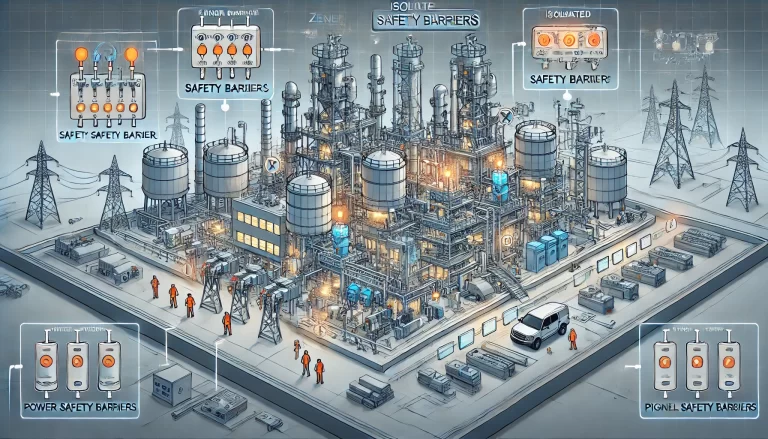HAZOP, which stands for Hazard and Operability Study, is a systematic and structured method used for identifying potential hazards and operational issues in industrial processes and systems. Initially developed for the chemical industry, HAZOP has since expanded into a wide range of high-risk sectors, including oil and gas, pharmaceuticals, nuclear power, and even aviation.
The Purpose of HAZOP
The primary objective of HAZOP is to improve process safety by:
- Identifying Potential Hazards: Finding where hazards may arise in a system due to deviations in operational parameters.
- Uncovering Operational Problems: Highlighting inefficiencies or design flaws that could impair the system’s operability.
- Proposing Mitigation Strategies: Suggesting corrective measures to reduce the risk and improve operational performance.

Key Principles of HAZOP
At the core of HAZOP is deviation analysis—a technique that focuses on exploring the potential deviations from design parameters within a system. This analysis is carried out on defined points, called nodes, which represent specific parts of the system, such as a section of pipeline, a vessel, or a reactor. The HAZOP team investigates each node to determine how deviations from the intended design or operating conditions could lead to risks or inefficiencies.
The HAZOP Analysis Process
HAZOP is a highly structured process that unfolds in a series of stages. The following outlines the main steps:
1. Defining the System
The first step in any HAZOP study is to define the boundaries of the system under review. This may be an entire facility, a single process, or even a subset of a process (e.g., a chemical reactor or heat exchanger). The team breaks down the system into nodes, each representing a location where the process parameters can be studied in detail.
2. Setting Design Parameters
For each node, the study considers several key process parameters, such as:
- Flow rate
- Temperature
- Pressure
- Composition
- Time/duration
These parameters represent the normal, intended conditions for that part of the system. Any deviation from these normal conditions can lead to hazards or inefficiencies.

3. Identifying Deviations Using Guide Words
To uncover potential deviations, the HAZOP team uses a set of predefined guide words. These guide words help structure the analysis by prompting the team to think of possible deviations. Common guide words include:
- No: A complete absence of a parameter (e.g., no flow, no reaction).
- More: Higher-than-normal levels of a parameter (e.g., more pressure, more temperature).
- Less: Lower-than-normal levels of a parameter (e.g., less flow, less temperature).
- As Well As: The presence of additional elements (e.g., other substances entering the system unexpectedly).
- Part Of: Only a portion of the expected parameter is present (e.g., partial flow or incomplete reaction).
- Other Than: Something different from the expected happens (e.g., an unintended reaction occurs).
Each of these guide words is applied systematically to the chosen parameters, allowing the team to think creatively about what could go wrong.

4. Investigating Causes and Consequences
For each identified deviation, the team then explores potential causes and consequences. This involves asking questions such as:
- What could cause this deviation? (e.g., a pump failure, human error, equipment malfunction).
- What would happen if this deviation occurred? (e.g., overheating, spills, fires, toxic releases).
This phase of the study is critical for understanding the full scope of risks associated with each potential deviation.
5. Evaluating Safeguards
Once the causes and consequences are understood, the team assesses the existing safeguards in place to prevent or mitigate these deviations. Safeguards could include:
- Alarms and control systems
- Pressure relief valves
- Operator training
- Emergency shutdown procedures
The team also considers whether the existing safeguards are adequate, or if additional controls are needed to address the risk effectively.
6. Recommending Actions
The final step in the HAZOP process is to document findings and make recommendations. If the team identifies deviations that pose unacceptable risks, they will recommend changes to the system design, operational procedures, or maintenance schedules. These recommendations may range from adding new safety features to revising operational protocols.

Example of HAZOP in Action
Consider a chemical reactor in a production plant. The team identifies one node, the inlet valve for raw materials, and applies the guide words to the parameter flow.
- No Flow: The team identifies that if no flow occurs, the reactor may run dry, potentially causing overheating and damage to the reactor. The cause could be a blocked inlet pipe, and the consequence could be severe equipment damage or safety hazards for operators. The existing safeguard might include a low-flow alarm, but the team might recommend installing a backup flow meter to provide redundancy.
- More Flow: In this scenario, an excessive flow of reactants could lead to an uncontrolled reaction, possibly generating excessive heat and pressure. A potential cause could be operator error or control valve malfunction. The consequence could be reactor rupture or an explosion. The team would evaluate whether current pressure relief systems are sufficient and might suggest increasing the capacity of the relief valve or adding an automatic shutoff.
These types of detailed analyses help ensure that systems are designed and operated as safely as possible.

Advantages of HAZOP
HAZOP provides several benefits for process safety management:
- Comprehensive: HAZOP’s structured approach ensures that all parts of a process are considered, preventing overlooked risks.
- Collaborative: A multidisciplinary team brings diverse perspectives, ensuring thorough analysis from different expertise areas.
- Customizable: HAZOP can be adapted to any process, making it suitable for a wide range of industries beyond just chemical plants.
Applications of HAZOP
Although originally developed for the chemical industry, HAZOP is now used across many sectors:
- Chemical and Petrochemical Industries: To identify process risks in refineries, chemical plants, and pipelines.
- Pharmaceuticals: To analyze batch production processes, ensuring product quality and safety.
- Nuclear Power: For assessing the operational safety of reactors and auxiliary systems.
- Oil and Gas: In offshore platforms and drilling operations, where safety is paramount.
- Aviation and Aerospace: For understanding risks in complex mechanical and electronic systems.

Challenges of HAZOP
While HAZOP is a powerful tool, it also comes with some challenges:
- Time and Resource Intensive: A full HAZOP study can be lengthy, depending on the complexity of the process.
- Requires Expertise: Success depends on the expertise and experience of the team members conducting the analysis.
- May Overlook Emerging Risks: HAZOP is best suited for well-established processes; it may struggle to account for risks in cutting-edge or highly novel technologies without additional foresight methods.
Conclusion
HAZOP is a critical tool in modern safety management, helping to identify and mitigate risks in complex systems and processes. By systematically examining deviations from the intended design, HAZOP teams can uncover both hazards and operational inefficiencies, leading to safer and more reliable operations across various industries. Through a collaborative, structured approach, HAZOP allows industries to prevent accidents, protect workers, and ensure the smooth operation of essential systems.
